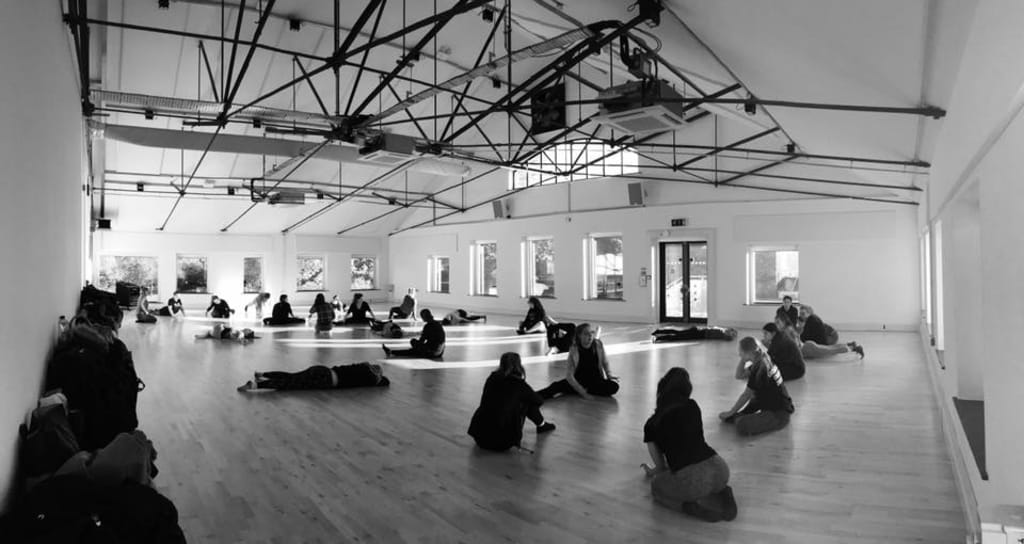To Improvise; To Do or Allow the Unexpected
Contact Improvisation: An Ongoing Research Lab

Contact improvisation, these are two words that make me feel very apprehensive. Contact Improvisation is a partnering dance form that was founded by Steve Paxton in 1972. The practice is based on a physical conversation between two or more bodies, exploring the principles of momentum, weight and touch. Applying techniques such as:
- Transfer of Weight
- Counterbalance
- Center of Gravity
- Touch Points
- Breath
- Rolling, Sliding, Pushing, Pulling
- Open Space for Bodily Investigations
- Sensitivity and awareness
Allows for a released flow of movement during the physical dialogue being created between bodies. From previous experience, I am aware that my body is not naturally tuned into the art improvising. Allowing myself to feel comfortable moving in the space takes time and focus.
Through my research I carried one quote in particular with me, “Sensations are what we feel to be happening at the moment, and they can become images when we take notice that we are observing them” (Paxton, 2003, p.182). As my practice developed I discovered that closing my eyes whilst moving became a valuable technique, one I often return to when lacking focus. Losing my vision, even briefly, allowed me to become present in the space, enabling me to clear my mind of any pre-existing anxiety and focus entirely on the body, drawing emphasis to the internal rather than the external. It is during these moments I become aware of my conscious and the sensations being carried through my body. Allowing myself to be moved only by these sensations and not by habitual movement. Heitkamp says, “One of the most important elements of contact improvisation is touch, both by touching and being touched, in the course of which a wide variety of information is exchanged through the skin.” (Heitkamp, 2003, p.256). Contact improvisation is about creating a relationship with another moving body, using these skin to skin connections to communicate and develop a mutual understanding and language of movement. This is something that becomes much more defined with each session of my practice. With each of my partners there was clear communication and empathy through each exercise. Knowing that the apprehensions you feel are shared by that of your partner allow for a foundation of trust to be built and create an encouraging environment to enable dancers flourish and grow in confidence.
“Contact Improvisation is an honouring of every moment. There is a sweet surrendering that happens when our bodies stay faithful to what is happening now, and now… and NOW! One learns to recognize and differentiate subtle impulses in our movement choices and our partner’s choices. We begin to decipher the cues that we give and receive which tell us when to lead or follow, when to go up, when to go down, where to touch, how to lift, when to slow down, and when to be still. In this form one learns to stay in integrity with each choice, never forcing, never rushing. When Body, Mind, and Spirit are united in their instinctive wisdom one finds ones-self at home in every moment expressing ones true nature.” - Moti Zemelman
Bibliography:
Heitkamp, D. (2003). Moving from the Skin: An Exploratorium. Contact Quarterly/ Contact Improvisation Sourcebook II, Vol. 28:2. Pp. 256 – 264.
Paxton, S. Drafting Interior Technique. In Stark-Smith, N. A Subjective History of Contact Improvisation. In Albright, A. C., & Gere, D. (2003). Taken by surprise: A dance improvisation reader. Middletown, Conn: Wesleyan University Press. Pp. 175 – 184
Zemelman, M. (no date) What is contact improvisation? Available at: http://www.contactimprov.com/whatiscontactimprov.html (Accessed on: 23 October 2018).
About the Creator
RBKH 120295
23. Dancer. Traveller.






Comments
There are no comments for this story
Be the first to respond and start the conversation.